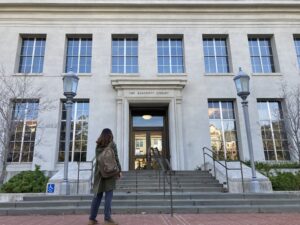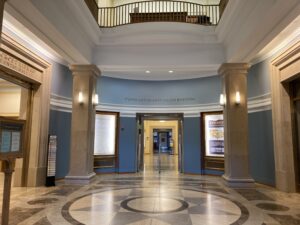By Lily Garcia, Undergraduate Library Fellow (2022-23)
One of my favorite activities I have done in the Undergraduate Library Fellowship program was walking through the east side of Doe Library and thinking about how to improve the wayfinding experience. According to the Oxford English Dictionary, wayfinding is the “act of finding one’s way to a particular place; navigation” (“wayfinding, n.”). The purpose of the activity was to use service design and design thinking principles to improve the visitor experience of navigating the library.

With maps in hand, my peer fellow Timothy, ULF mentor Vaughn, and I walked outside to the entrance of the Bancroft Library. We were attempting to view the space as if for the first time–to imagine what we would find confusing, misleading, and the overall message the space was projecting. Staring closely at the architecture, I was overwhelmed by the grandness. Thirty-four rectangle windows defined the front of the granite building. After walking up two flights of stairs and past two towering lantern-style lamp posts, I reached the recessed doorway. Bronze doors with darkly tinted glass cloaked the interior with mystery. Inside, gold-colored letters told me I was now standing in the “Wayne and Gladys Valley Rotunda.” French blue walls, marble and onyx floors, and four rectangular columns communicated the seriousness and prestige of the space. While I was mesmerized by the elegance, I was also aware of how intimidating it was. There was no welcome banner by the entrance or inside map of the floor plan with a big red star indicating that “You are HERE.” The design of the space communicated an expectation of knowledge, which could feel daunting to any visitor trying to navigate their way for the first time. Once we finished our examination, I was left with an impression of how influential architectural spaces are–that they can come across as exclusive or inclusive.

With this idea in mind, I reflected on Timothy and I’s first research consultation. A student wanted help finding a historical, first-hand account. They had exhausted their digital resources and were stuck. We recommended that the student try looking at UC Berkeley’s physical collections. Shyly, they confessed to never going into Main Stacks before, and I offered to go with them. Employing my park guide skills, I took the student on a grand tour of the stacks, showing them where they go through security, how to use the floor maps, what range finders are, and how to exit the building. We ultimately found a book with the information the student was looking for on level C in the west wing. They were grateful and told me they would have been lost if they had been by themselves but now felt comfortable visiting Main Stacks and would be back.
These experiences taught me how wayfinding influences and is itself a part of the research process. When we enter academic research institutions, their architectural design sends a message. We can feel welcomed or overwhelmed and daunted. The same idea applies when we navigate digital spaces and conduct research online. A database or library guide can be helpful or discouraging based on its design and our experience interacting with it. My goal as a Research Fellow is to help my peers find their way through the research process in either the physical or digital space and support making the UC Berkeley Library a place of inclusion.
Works Cited
“wayfinding, n.” OED Online, Oxford University Press, September 2022, www.oed.com/view/Entry/426203.